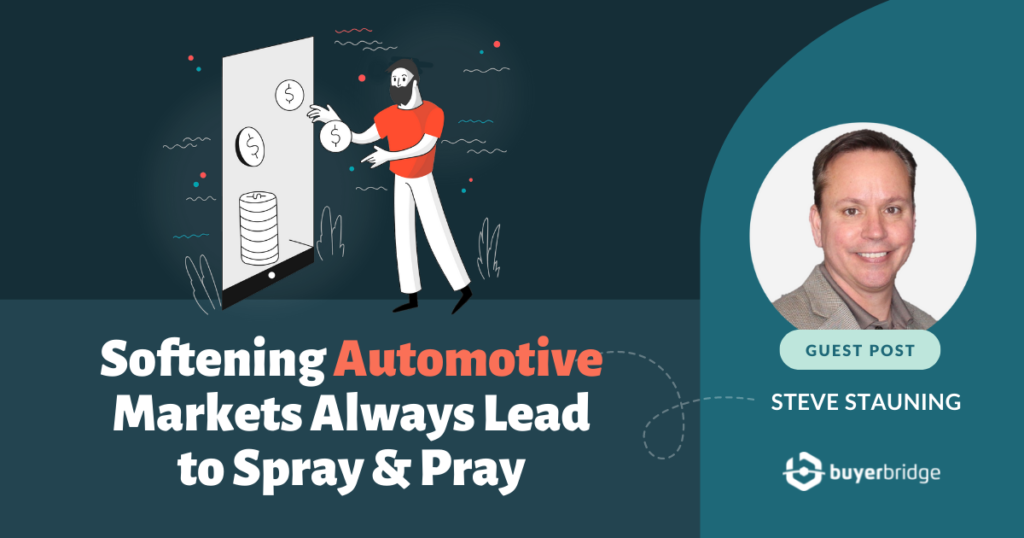Having lived through more than a few ups and downs in automotive retail, there is one constant about advertising that’s been true for decades. That is, when the market begins to soften, managers and dealers most often look for answers from (and place the blame on) their marketing budgets.
Whether they make knee-jerk vendor replacements or start chasing potential buyers across multiple channels, they usually do this without much data – these are gut decisions. Selling fewer vehicles? We need to spend more, be in more places, and/or fire our marketing vendors! Spray and pray, because if we throw enough crap against the wall, some of it will stick!
When coupled with the new norm of the Nomadic Customer, the current market softness is already leading to spray and pray decisions that are more costly than in the past and resulting in lower overall reach. That is, while dealers are ramping up spending, they’re connecting with fewer car buyers.
Today’s automotive Nomadic Customer is more than a moving target; they’re fleeting. Specifically, they never seem to be in any one place for very long. Additionally, the inventory shortages over the last 24+ months have taught today’s customers to look for vehicles in even more places than ever before.
Cross-Shopping is Creating Inefficiencies
In the past, dealers seeking additional exposure to their inventory could double-up (or triple-up) on classified websites, buy leads from other third-party providers, and spend more on Google Ads. These strategies offered some incremental exposure, as cross-shopping (consumers visiting multiple third-party sites) was limited, and Google provided search term-level data in Google Analytics dealers could use to fine tune their spend.
The problem with these strategies today is that the current low-funnel buyer is everywhere. They are, after all, the automotive Nomadic Customer. As these consumers cross-shop multiple classified websites, dealers end up paying double, triple, or even quadruple to reach the same potential buyer. Plus, Google Ads have become too expensive, and now – under the guise of “privacy” – Google hides nearly all consumer search terms from their advertisers’ Google Analytics.
Spray and pray in the past was just costly; today, it’s costly and inefficient.
Too Many Choices
In the past, car buyers had few available media options. Decades ago, there was likely one daily newspaper, three or four channels on television, and just a handful of popular radio stations in each market. Add in a couple of strategically placed billboards, and car dealers practicing spray and pray could afford to be nearly everywhere.
Today’s consumer has too many choices and a shortened attention span. To gain the same relative exposure now would bankrupt your dealership.
Whether online or the old fashioned way, relatively few consumers read their local paper daily; and almost no one reads it from cover-to-cover as they did in the past. Your online and offline ads are almost never seen by the Nomadic Customer.
Although about 80% of Americans watch television on a given day, they’re not all watching the same three or four channels – in fact, many are watching a premium streaming service without commercials. Even if you’re hyper-targeting with over-the-top media, between their shorter attention spans and the ease of channel surfing, the automotive Nomadic Customer is missing your messages.
An astonishing 88% of Americans still listen to more than twelve hours of radio each week. Of course, only about one of every six of these listeners is going to buy a car in the next twelve months. If your goal is to reach the in-market buyer – say, someone looking to buy in the next 30 days – then only about 1.5% of those hearing your ads today is likely to buy this month. There is no tangible ROI if your goal is to reach the Nomadic Customer.
It’s Digital or Bust
As most dealers already know, the remaining option is digital marketing. While digital marketing in the past promised lower acquisition costs coupled with superior tracking and measuring, the realities caused by the automotive Nomadic Customer and privacy challenges are leading to bloated budgets with little or no measurable return.
Reaching the Nomadic Customer without breaking the bank is the problem; and the answer – if there is going to be one – will depend on finding solutions that can effectively be everywhere at all the right times. Because the market will soften (if it hasn’t already for you), and dealers can no longer rely on their gut plus a little spray and pray to drive today’s buyers into their stores.
Find out everything you need to know to catch and convert the #1 most unreachable car shopper today.






